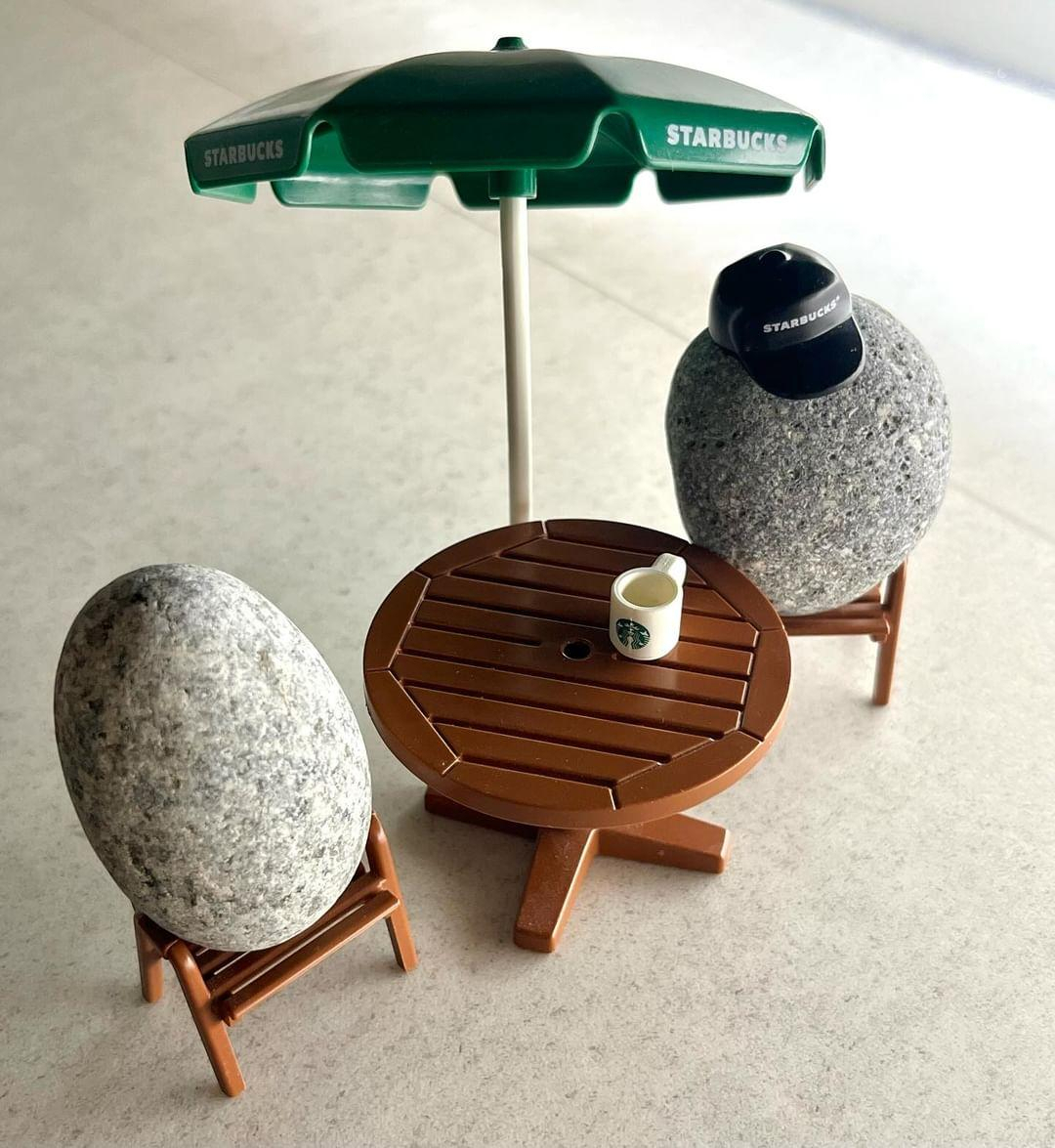 |
Pet stones with Starbucks-themed miniature props (Courtesy of Ji-eunnnn7 on Instagram) |
Some perhaps remember a stone slab from director Bong Joon-ho’s Academy Award-winning film “Parasite,” which Ki-woo, one of the main characters, holds onto throughout the film. In the film, his friend Min-hyuk delivers the stone, stolen from his grandfather’s collection, telling Ki-woo the stone will bring wealth to his family.
The stone, which is known as "suseok" or scholar’s rock here, is a collectible item that was prominent among scholars during the Joseon Dynasty. Suseok regained popularity during the late 20th century and emerged as a collectible item among businessmen who started to accumulate wealth during the country’s economic boom. Suseok was believed to be a lucky charm that would bring good fortune and wealth and also became an object that would add sophistication to houses or offices.
“I remember my grandparents having several scholar’s rocks on their shelves. Some of them had eye-catching shapes and colors. I also recall them being carefully displayed along with expansive orchids,” Park Sung-won, a 36-year-old man living in Seoul, said.
The rock-collecting culture here, however, faded away in past decades until it recently made a comeback during the COVID-19 pandemic. This time, stones that people collect have become significantly smaller, and the reasons for collecting stones have also changed dramatically.
If suseok was more of a collectible object to display, people nowadays seem to buy stones, what they call “pet stones,” out of loneliness.
“I purchased a pet stone for the first time during the pandemic. I just wanted to have something by my side while I was working remotely. It provided me a sense of companionship,” Lim, a 29-year-old woman who owns a pet stone, said.
People who have pet stones tend to personify them. In many online social media posts, they put pictures of their pet stones as they would do with their pet animals. People also give the stones nicknames, prepare beds where they can rest, provide clothes and decorate them as if they were alive.
“I would occasionally pick my stone up from its bed and pat it. I sometimes just talked to it as if I was talking to myself,” Lim added.
Although it is not the most popular hobby yet, there is a growing number of people who purchase pet stones, according to an online pet stone seller. “We sell about 300 pet stones a month. Our main customers are women who are in their 20s and 30s,” the owner said.
Pet stones are affordable when compared to raising dogs or having suseok. Pet stones here range between 6,000 won ($4.5) and 10,000 won, meaning that they are more accessible than suseok, which can cost up to tens of thousands of dollars.
Pet stones seem to be perceived by people as a good medium to calm down their minds, a local artist said. “There are many young people who apply for my workshops where I teach painting on pet stones,” artist Kim Hyung-ki said.
“Many of us have memories of playing with small stones when we were younger, and people, including myself, seem to more easily get attached to stones,” Kim added. “Some people who come to my workshops seem to use the act of painting on the stones to refresh their minds.”
The psychology underlying the pet stone culture is also fragmentation within our society, the absence or underdevelopment of connections between society and the grouping of certain members within it, according to experts.
“I have seen that many younger people who growingly feel stressed about maintaining relationships tend to easily walk away from their relationships and turn to other measures to deal with loneliness,” said Jeon Mi-young, a research fellow at the Consumer Trend Center of Seoul National University.
Raising pets has been one of the popular measures that help them handle loneliness, and carrying a pet stone is similar as it provides a sense of connectedness. The difference is that raising a pet stone is a lot more efficient than raising pet animals or plants because there is almost no effort needed to take care of something that is not alive.
Owners of pet stones also said one of the benefits of having pet stones is that they do not demand attention as normal pets usually do. “I cannot raise cats or dogs because I have to work. I like having pet stones because I don’t have to worry about feeding or walking them,” said Park, a 31-year-old female who works and lives in Seoul.
Raising a pet stone may fall into Asia’s popular tradition of collecting stones, marked by Korea’s suseok, Japan’s suiseki and China’s gongshi. But, the motive behind it is something new.
For instance, “If collecting action figures is a way to satisfy one’s taste, those people who collect stones seem to focus more on their relationship with their stones,” Jeon said.







![[Today’s K-pop] Blackpink’s Jennie, Lisa invited to Coachella as solo acts](http://res.heraldm.com/phpwas/restmb_idxmake.php?idx=644&simg=/content/image/2024/11/21/20241121050099_0.jpg)